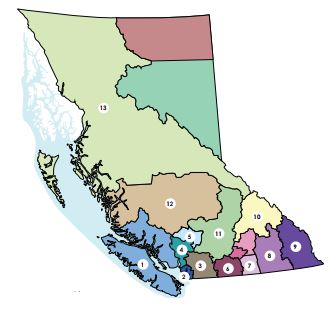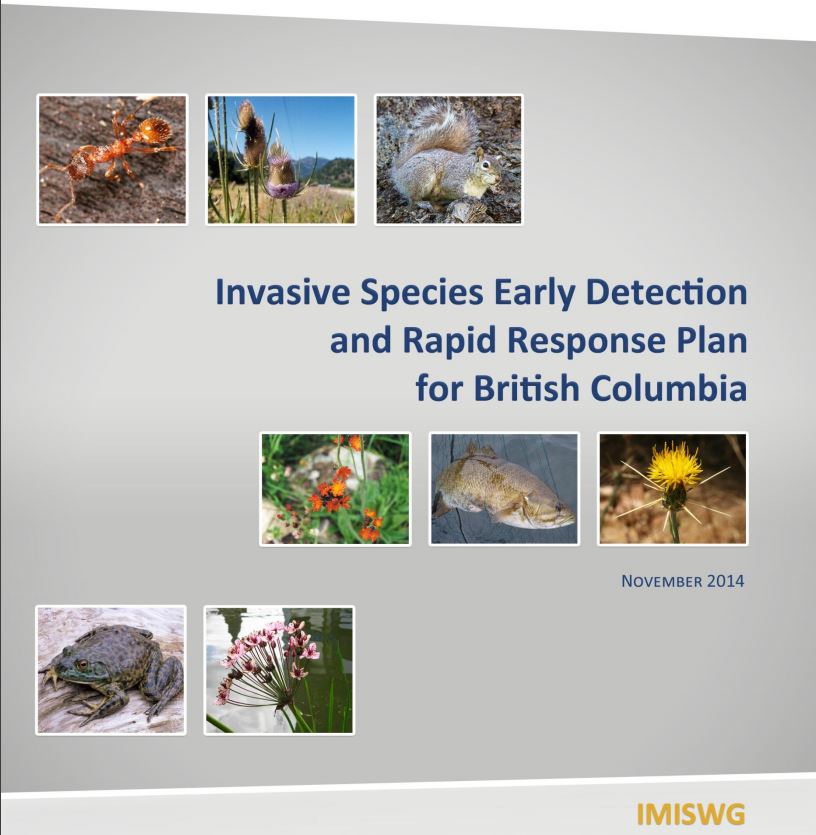The Invasive Species Council of BC

The Invasive Species Council of BC is a collaborative-based non-profit organization committed to reducing the spread and impacts of non-native species within BC. The ISCBC focuses on uniting efforts of the various partners working on invasive species management in BC, educating and informing British Columbians, coordinating and communicating research efforts, and offering training programs.
The SSISC works collaboratively and cooperatively with the Invasive Species Council of BC, on various provincial scale prevention programs including Clean Drain Dry, Plantwise, Don’t Let it Loose and Play Clean Go. We also participate in regular Joint Strategic calls with ISCBC and provide input on provincial scale initiatives like the Invasive Species Strategy for BC.
Regional Invasive Species Organizations
The SSISC is one of 13 independent Regional Invasive Species Organizations (RISOs) working to stop the spread of invasive species throughout BC. We work closely and collaboratively with the other RISOs, sharing knowledge and expertise regarding on-the-ground invasive species management, working together on consistent messaging for education & outreach programs, and collaborating on program ideas, professional development and funding applications. A full list of BC RISOs can be found if you scroll to the bottom of this page.
BC Inter-Ministry Invasive Species Working Group
The BC Inter-Ministry Invasive Species Working Group (IMISWG) consists of representatives from provincial government ministries that have responsibility for invasive species management, including Ministries of Forests, Lands, Natural Resource Operations & Rural Development; Agriculture; Environment; Transportation and Infrastructure; and Energy and Mines. The IMISWG:
- brings together provincial ministries and agencies, each with unique mandates, program goals and technical expertise;
- provides policy direction, coordination and collaborative delivery of provincial invasive species programs for the Province of BC;
- collaborates extensively with stakeholders including First Nations, the ISCBC, local and federal governments, regional invasive species organisations, and neighbouring jurisdictions in the US and Canada;
- oversees the development and enhancement of biological control of invasive plants for BC;
- develops information bases and decision support tools for invasive species management that incorporate both economic and environmental parameters;
- oversees the Early Detection and Rapid Response Plan for BC (see below); and efforts to prevent the arrival and establishment of high risk aquatic invasive species.
The Invasive Species Strategy for BC
The Invasive Species Strategy for BC is a strategic framework for improved invasive species management in British Columbia. It offers a foundation for invasive species work across BC and provides key recommendations and actions needed to achieve effective invasive species management. The Invasive Species Council of BC is the secretariat of the Strategy, and the ISCBC incorporated input from stakeholders across BC, including the SSISC, to update the Strategy for 2018-2022.
BC’s Early Detection & Rapid Response
Early Detection Rapid Response (EDRR) is a proactive approach to managing new invasive species to BC that prevents establishment and subsequent impacts through targeted species risk assessment, verification, containment and eradication. BC EDRR activities are guided by the BC Invasive Species EDRR Plan, which provides detailed direction on the decisions and actions required to address new incursions anywhere in BC.
Provincial Priority Species Profiles – The BC IMISWG has evaluated candidate species for EDRR to determine likelihood of occurrence, establishment, spread and assessed which pose the greatest threat to BC’s environment, economy and human health. The resulting province-wide list represents the top threats to BC from all categories of species – plants, animals, insects and other.
BC’s Invasive Mussel Defence Program
BC Invasive Mussel Defence Program – refer to this page for information about:
- BC Watercraft Inspection Program
- Zebra & Quagga Mussel EDRR Plan for BC
- Lake Monitoring for the presence of invasive Zebra and Quagga mussel larvae (SSISC has been participating in this program in 2017)
- Legislation, resources, reports and more
Pest Management Plans
Pest Management Plans (PMPs)
Pest Management Plans (PMP) outline an Integrated Pest Management approach for the control of invasive plants on provincial public land, and include prevention strategies, manual/mechanical treatment methods, biological and cultural control methods, and chemical control methods. There are 4 plans for BC, covering Southern Interior, Central & Northern BC, South Coastal, and South Coastal Mainland (the region that SSISC lies within).
The Invasive Alien Plant Program (IAPP)
IAPP (Invasive Alien Plant Program) is a BC-wide spatial, relational database that contains invasive plant site and survey data, treatment and monitoring data for the province of BC. The data in IAPP is entered by a wide variety of user groups including SSISC, on an on-going basis.
The SSISC maintains a more detailed internal geodatabase for both plant and animal survey, treatment and monitoring data. Site-scale invasive plant survey and treatment data from SSISC’s internal database is uploaded annually to IAPP, and available to the public via BC iMap, and as a downloadable shapefile through DataBC.
Biocontrol Program
The Biocontrol Development staff of the Ministry of Forests, Lands and Natural Resource Operations’ Invasive Plant Program provide new biocontrol agents to invasive plant managers in British Columbia by enabling research into potential new biocontrol agents and developing received agents into management tools. Read more about the program here.
BC Regional Invasive Species Organizations
A network of independent Regional Invasive Species Organizations exists throughout British Columbia. Please contact them for more information about invasive species management for the areas they cover.
We work in close collaboration and cooperation with the regional organizations listed below.
Lillooet Regional Invasive Species Society
LRISS covers all lands within electoral areas A and B of the Squamish-Lillooet Regional District, including the northern extent of the Cascades Forest District and the boundary of the Northern St’àt’imc Territory, including waterways of the Fraser River, Bridge River, Cayoosh Creek, and Seton Lake.
www.lriss.ca |Email: lrinvasives@gmail.com
Metro Vancouver – Invasive Species Council of Metro Vancouver (ISCMV)
The ISCMV covers all lands within the Metro Vancouver Regional District.
Ph: 604-880-8358 | www.iscmv.ca | Email: info@iscmv.ca
Fraser Valley – Fraser Valley Invasive Species Society (FVISS)
The FVISS covers the Fraser Valley Regional District boundaries, from east of Hope to west of Abbotsford/Mission, and north to Skatin and Lil’wat territory. Adjacent communities may also be included in the FVISS where invasive species infestations are observed.
Ph: 778-548-FVIS (3847) | https://fviss.ca | Email: info@fviss.ca
Vancouver Island and Sunshine Coast – Coastal Invasive Species Committee (Coastal ISC):
The Coastal ISC covers the geographic areas of Vancouver Island, the Gulf Islands and the Sunshine Coast.
Ph: 250-857-2472 | www.coastalisc.com | info@coastalisc.com
Okanagan-Similkameen – Okanagan and Similkameen Invasive Species Society (OASISS)
OASISS covers all lands within the Regional District Okanagan-Similkameen (RDOS), including the municipalities of Summerland, Penticton, Oliver, Osoyoos, Keremeos and Princeton.
Ph: 250-404-0115 | https://www.oiso.ca | Email: oasiss@shaw.ca
Columbia-Shuswap – Columbia Shuswap Invasive Species Society (CSISS)
The CSISS covers all land within the Columbia-Shuswap Regional District.
Ph: 1-855-785-9333 | www.columbiashuswapinvasives.org | Email: info@columbiashuswapinvasives.org
Boundary – Boundary Invasive Species Society (BIS)
BIS covers the municipalities of Midway, Greenwood, and Grand Forks, as well as Electoral Areas D &E of the Regional District of Kootenay Boundary.
Ph: 250-446-2232 | www.boundaryinvasives.com | Email: boundaryinvasives@gmail.com
Central and West Kootenay – Central Kootenay Invasive Species Society (CKISS)
CKISS covers the Central Kootenay Regional District and areas A & B of the Kootenay Boundary Regional District from the Paulson Summit East.
Ph: 1-844-352-1160 | www.ckiss.ca | Email: info@ckiss.ca
East Kootenay – East Kootenay Invasive Species Council (EKISC)
The EKISC covers all land within the Regional District of East Kootenay.
Ph: 1-888-55-EKISC (35472) | www.ekisc.com | Email: info@ekisc.com
Northwest – Northwest Invasive Plant Council (NWIPC)
The NWIPC covers four regional districts: Bulkley- Nechako, Fraser Fort George, Kitimat-Stikine, and Skeena Queen Charlotte; and, the Stikine Region adjacent to the Yukon border, and all municipalities within these regions.
Ph: 1-866-44WEEDS (449-3337) | www.nwipc.org | Email: manager@nwipc.org
Cariboo Regional District (CRD)
Ph: 1-800-665-1636 ext. 266 | https://www.cariboord.ca/en/home-and-property/invasive-plants.aspx | Email: invasiveplants@cariboord.bc.ca

Cariboo, Chilcotin, Coast – Cariboo Chilcotin Coast Invasive Plant Committee (CCCIPC)
The CCCIPC covers the Cariboo Regional District and the Central Coast Regional District. This ranges from Hixon north of Quesnel, south to 70 Mile House, east to Wells Grey Park, and west to the Pacific Ocean.
Ph: 250-855-9333 | Email: info@cccipc.ca




















